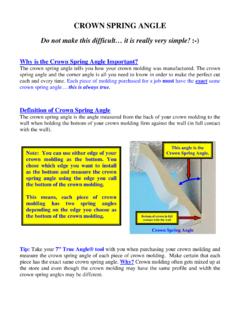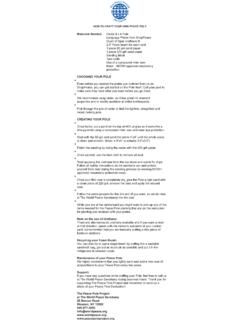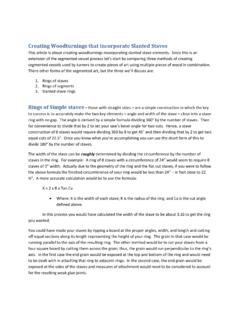Transcription of Compound Miter Cuts
1 20 Kapex KS120 Miter Saw Compound Miter cuts Compound Miter cuts are where the saw is both in a Miter position and a bevel position at the same time. There are several applications for Compound Miter cuts , but cutting crown moulding and sloped miters are common examples. The example below shows a very simple birdfeeder roof. The greatest challenge with Compound miters is determining the proper saw settings to achieve the desired Miter angle. These saw settings can be found in look-up tables for standard mouldings, but for non-standard angles, determining the proper saw settings requires mathematical calculation.
2 Note that there are several methods for accurately cutting crown moulding depending on the circumstances. Make sure to review the methods described in the applicable section on page 21. Calculating Compound Miter settings requires two parameters from the desired joint: the corner angle and the slope. Corner Angle The corner angle is the angle between the two pieces, when viewed looking straight down on the joint. The corner angle is relatively easy to determine, but it is also the value that can cause the greatest amount of confusion for many woodworkers. That s because most woodworkers view angles differently than a mathematician will.
3 A woodworker typically considers both inside and outside corners as 90 degrees (with a 45 degree Miter ) even though a mathematician would make the distinction that one corner is 90 degrees and the other is 270 degrees. To be consistent with Miter saw settings, the corner angle is measured from a straight line between the two pieces, as shown above. Slope The Slope angle is the angle that each piece makes with respect to the base of the corner, such as the ceiling or floor in the examples provided here. For a roof-like structure, this would be the pitch of the roof. For crown moulding, this would be the compliment of the Spring Angle of the moulding.
4 Common spring angles for mouldings are 38/52 and 45/45. Determining the Corner Angle of Polygons The corner angle for standard polygons is shown in the table on page 18. Using the MiterFast Tool to Find a Corner Angle For non-standard corner angles, such as a room that is slightly out of square, the MiterFast tool can be used to determine the corner angle. To use the MiterFast tool to measure the corner angle, follow the Using the MiterFast Tool procedure on page 15, but instead of making the cut, record the saw s Miter setting angle. This angle is the corner angle, so multiplying by 2 will give you the corner angle.
5 (The Compound angle calculator on page 21 also has an option for letting you enter this angle directly without needing to double it.) Determining the Slope of a Pyramid (Polyhedron) A polyhedron is a pyramid that can have any number of sides. The easiest method for determining the slope of the polyhedron is by measuring the Drop and Projection of one face. These are the distances from the center-to-the-edge, and the base-to-the-point of the pyramid. Note that with a polyhedron with an odd number of sides, the center is found by drawing bisecting lines as shown in the image below. Determining the Slope of Crown Moulding As was mentioned previously, the slope of a crown moulding is the compliment of its Spring Angle (the spring angle is measured relative to the wall, and the slope is measured relative to the ceiling).
6 The two common spring/slope angles of crown moulding are 38/52 and 45/45. The reason why these angles are represented by dual numbers is because the actual angle depends on which direction the moulding is oriented. For example, turned one way, the slope is 38 degrees, but turned the other way, the slope is 52 degrees. Note that the sum of these two angles is always 90 degrees. For mouldings that are not the standard 38/52 or 45/45, you will need to measure the moulding to determine its slope. This is very similar to measuring the Drop and Projection of a pyramid, but more care needs to be taken to ensure the measurements are taken from the correct locations.
7 Important: The slope of a moulding does not necessarily coincide with the points or Tails of the moulding. The slope is measured from the back-side of the moulding, regardless how long the tails of the moulding may extend (see image below). Calculating Compound Angles There are two separate equations for calculating a Compound angle. One equation is for calculating the Miter setting of the saw, and the other equation is for calculating the bevel setting of the saw. () =SlopeeCornerAnglCos2 TanArcTanMiter () =SlopeeCornerAnglSin2 SinArcSinBevel If you don t know the slope angle, but you know the Drop and Projection, then use the following to calculate the slope: =ProjectionDropArcTanSlope The most common error in calculating Compound angles is using the wrong Corner Angle.
8 As a double-check to your calculations, for nearly all cases, the Corner Angle should be less than 100 . The only time the angle should be significantly larger than 90 is either for a 3-sided box, or a wall corner with a sharp edge. Compound Angle Calculator A Compound angle calculator has been built into this Adobe Acrobat PDF file. If you do not have an original electronic version of this manual, visit the website to download a copy. Slope Angle Options Drop Slope Angle Projection Corner Angle Options Corner Angle MiterFast Tool Angle Results Miter Setting Bevel Setting Note: If you are unsure about the corner angle you have entered, check the calculated MiterFast Tool Angle value.
9 This number should be no more than 60 degrees for sharp corners, but otherwise, it should always be less than 45 degrees for most corners. If it is significantly greater than 45 degrees, then you probably have the wrong Corner Angle. Supplemental User s Manual 21 22 Kapex KS120 Miter Saw Crown Moulding There are several methods for cutting crown moulding, and each method has its benefits depending on the specific application. The most common method for cutting crown moulding is to use a standard Miter cut, where the moulding is tilted against the fence of the saw. For unusual situations, or when the moulding is too large to fit against the fence, Compound miters are used.
10 In some applications, inside corners are made using a method called coping. Each of these methods will be described briefly. Standard Miter A standard Miter cut is the easiest and most common method for cutting crown moulding. The Kapex Miter saw has an optional auxiliary crown moulding fence (also called the Crown Stop) specifically for making this type of cut. The fence holds the moulding at the correct angle so it can be cut with a normal Miter cut. For this type of cut, you place the moulding on the saw as it would normally rest in the installed position. The edge that normally faces the ceiling is the edge that should be on the base of the saw.








